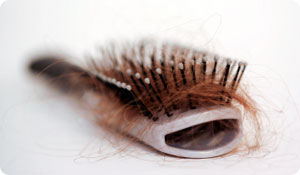
Concerned about thinning hair? According to the American Hair Loss Council, female pattern baldness affects about a third of all susceptible women. It usually affects post-menopausal women, but can start as early as adolescence. Generally, female hair loss has three causes: a system shock (stress alopecia), auto-immune disease (alopecia areata), or a genetic predisposition to pattern hair loss (androgenetic alopecia).
How Hair Grows
Each hair follicle spends 4-6 years growing in the anagen phase, rests for 2-4 months in the telogen phase, then pushes the old hair out with a new strand of hair. At any given time, 90% of your hair is growing and 10% is resting. You lose about 100-150 strands of hair a day, slightly less if your hair is already thin.
When Growth Stops: Stress Alopecia
When hair falls out in clumps, it's often because of an interruption in the growth process. Medications like chemotherapy drugs can poison the hair follicle and temporarily stop it from growing. Or a general system shock can cause hair follicles to enter the resting phase out of cycle, leading to batch fall-out. Physical or emotional stress, a thyroid or hormonal change, extreme weight loss, or medications like high-dose Vitamin A, blood pressure and gout medications can all cause stress alopecia. It can take 2-3 months for stressors to hit and for hair to start to fall out in a general pattern. These growth interruptions are reversible, once the cause of the growth impeding factor is stopped.
Patchy Hair Loss: Alopecia Areata
Affecting 4 million Americans, alopecia areata is an autoimmune disease that causes antibodies to attack groups of hair follicles leading to hair loss anywhere from the scalp to the entire body. The exact cause of this is unknown, but it's thought to be genetic and often occurs in conjunction with other auto-immune diseases.
Thinning/Pattern Hair Loss: Androgenetic Alopecia
In contrast to male pattern baldness, androgenetic alopecia in women starts on the top or sides of the scalp instead of the crown. It's also thought to be a genetic condition. Some of treatment options available to men, such as Finasteride, have dangerous side effects for women. More research is needed for the best treatment options, but the over-the-counter drug Minoxidill is effective in about 20% of women. Surgical options include hair transplantation, where tiny follicles of hair are transplanted to areas of the body where thinning hair occurs. Another option is scalp reduction, where areas of skin still producing hair are stretched over scalp areas that aren't.
Damaging Hair With Styling
If you are experiencing thinning hair that's not due to disease or trauma, you may wonder if styling products and chemicals are adding to your hair loss. The answer is: maybe. Repeated stress like pulling hair into tight ponytails or braids for extensions can damage the follicles and causing thinning in the temple area. And bleaching, dying, and the chemicals used in permanents or straightening products can cause breakage. However, if the follicle itself is not damaged, then the hair will grow back.
Speak to a medical professional about available options. In many cases genetics may be to blame for your hair loss, but there may be adjustments in medication, lifestyle or diet that can help the problem.
Sources:
American Osteopathic College of Dermatology
http://www.aocd.org/skin/dermatologic_diseases/female_pattern_hai.html
North American Hair Research Society
http://www.nahrs.org/home/Default.aspx?tabid=64





